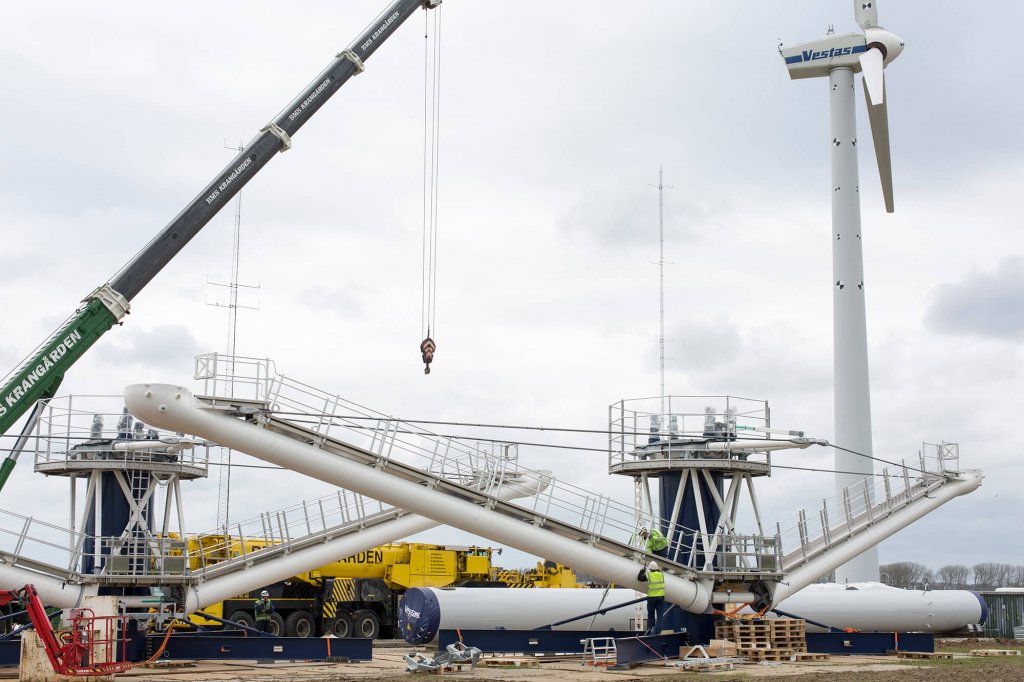
In cooperation with the Technical University of Denmark, Vestas is installing a concept demonstrator to test the technical feasibility of operating and controlling a multi-rotor turbine.
The concept of a wind turbine with multi-rotor arrays is nothing new. Back in 2009, a company named Greenward Technology designed what it called the “Wind Turbine Quad Array,” which mounts four smaller turbines on arms to capture as much energy as a conventional unit with a 100-m diameter rotor. It seems the model never made it passed the 1-m scale, and the company no longer exists.
In 2014, UK company aerotrope worked with GL Garrad Hassan to engineer the support structure and yaw system for the “OWES 5-MW” 16-rotor array (you can download a related 2014 presentation here).
Times are changing. Global turbine manufacturer, Vestas, is taking the concept to the next level. In cooperation with the Technical University of Denmark, the company is installing a concept prototype to test the technical feasibility of operating a multi-rotor turbine. The prototype is under construction at the Risø test site near Roskilde, Denmark.
So why bother with multiple rotors, you may ask? There are several viable reasons but they all come down to cost — and size. Today’s tallest towers reach 150 meters. Some companies plan for greater heights. Taller turbines mean longer and heavier blades and components. With all that weight comes related costs for material, manufacturing, transportation, installation, and maintenance.
With its “concept demonstrator,” Vestas is challenging the scaling rules that turbines have to grow in size to increase their energy capacity and production. A multi-rotor turbine may benefit from reduced structure loading and weight from blades, hub, and the drivetrain compared to conventional turbines. Less weight and smaller-size components also reduces transportation challenges. The smaller unit size may also mean an array produces greater aerodynamic efficiency and more power.

The purpose of the multi-rotor concept is to explore a different approach to lowering cost of energy by challenging turbine scaling rules.
Vestas’ multi-rotor demonstrator uses four refurbished V29-225 kW nacelles (which the company produced from 1990 tot 1997), mounted on a support structure that consists of a tower with arms that each yaw individually upwind. Rotor arms are braced with steel tension cables that offer a flexible, lightweight mount that can reduce mass and loads. The prototype’s tip height of 74 m is notably shorter than many of today’s turbines but it meets Risø’s building height restriction (of 75 m).
The demonstrator is well instrumented to measure factors such as load, wind speed, power production, and ambient conditions including temperature and humidity. A LiDAR system is also positioned at the top of the support structure to measure the wind field in front of the rotors. Throughout the year of test operation, data will undergo ongoing analysis to assess the feasibility of the multi-rotor concept.
Vestas is confident in its design but admits the prototype’s future success depends on several factors. Many new load and control features still need developing and testing to assess the technical and commercial feasibility of the multi-rotor array. For example, the rotor is also a concept demonstrator to assess potential challenges and is not for sale.
Vestas is investigating three main technical areas during operation of the multi-rotor demonstrator: structural dynamics (testing for unforeseen vibrations in the structure), aerodynamics (because the rotors sit quite close to one another, it’s important to discover how they interact), and loads (how accurately they can be predicted and adjusted over time).
“Installing a concept turbine shows that innovation sometimes entails entirely new thinking and approaches. This process of continuous innovation and exploration is extremely important,” said Jorge Magalhaes, Senior Vice President, Vestas Innovation & Concepts, in a recent press statement. “It provides us with essential knowledge that can help us bring down our products’ cost of energy and integrate key technologies to solve customer challenges.”
He added: “Ultimately, the goal is to assess if we can build an even more cost-efficient turbine by challenging the scaling rules.” Vestas reveals a bit more in its video here.
Filed Under: News, Turbines




